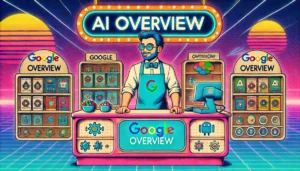Chatbots On Websites Have Always Been Around, What’s Different Now in 2025?
Chatbots have long been the trusty pop-up helpers on business websites, but in 2025, powerful AI and Large Language Models (LLMs) are taking them to a whole new level. Gone are the days of rigid, pre-scripted answers—modern chatbots adapt to your customers’ needs, learn from interactions, and deliver genuinely helpful conversations. If you’re a business
Have you ever interacted with a little chat window that pops up in the corner of a website? Chances are, you have. Chatbots have been around for quite some time, helping businesses handle frequently asked questions, direct visitors to the right pages, and sometimes even schedule appointments. But if you’ve been following chatbot trends lately, you might have noticed something significant happening in 2025: these automated helpers are suddenly a lot smarter, thanks to artificial intelligence (AI) advancements—particularly Large Language Models (LLMs) like GPT-based systems.
Unlike the old days when a chatbot might respond with pre-written scripts that barely addressed your question, the new generation can engage in a conversation that feels natural and helpful. If you run a business and have a website, it’s worth paying attention.
A Quick Look Back: The Early Days of Website Chatbots
Let’s rewind the clock. Traditional chatbots started popping up on business sites over a decade ago, often featuring a small chat window that asked questions like, “Hello! How can I help you today?” As soon as you typed your query, the bot would try to match your keywords to a scripted response. If it recognized “pricing,” for instance, it might show a pre-written paragraph about your product costs.
These old-school bots weren’t exactly “intelligent.” They worked off if-this-then-that logic—like a flowchart. If the customer said “shipping,” the bot would provide shipping info; if the customer said “contact,” it would share a phone number or email. While that definitely saved time compared to having a live agent answer the same questions all day, the experience often felt stiff. If you asked something slightly off-script—say, “Which shipping method is fastest?”—the chatbot might respond with a blank stare (or, more accurately, a confusing default message).
Yet, despite these limitations, these early bots were a big deal for small businesses. They provided 24/7 customer engagement and showed that your company was forward-thinking, even if the chatbot’s abilities were narrow.
The Game Changer: LLMs and the Chess vs. Go Analogy
To understand what’s driving this big leap in chatbot technology, think about the difference between the board games Chess and Go. Historically, computers learned to play Chess quite well by brute force—checking many possible moves quickly. Chatbots of the past functioned similarly: they scanned for certain keywords and matched them to predetermined answers. This works fine for structured problems but isn’t as flexible for more nuanced or wide-ranging queries.
Go, on the other hand, has far more possible moves; teaching a computer to excel at Go requires a different, more advanced approach. The system had to “learn” patterns and strategies in ways that brute force alone couldn’t handle. Fast forward to modern AI research, and we find deep learning algorithms that can master Go at a superhuman level by analyzing countless game scenarios and adapting their strategies.
When we apply this to chatbots, old-school, rule-based models are like chess engines—they follow scripts and can handle straightforward, structured questions. New AI-driven chatbots are closer to the Go-playing AI, making sense of wide-ranging, unpredictable inputs. They can converse on a wide range of topics, adapt their responses based on context, and even learn from past interactions.
What’s So Different Now in 2025?
Advanced Natural Language Understanding
Thanks to LLMs, chatbots can now understand questions and statements in a far more nuanced way. They look at the entire context of what you typed, rather than just picking out a keyword or two. This can lead to human-like conversations where users feel truly heard and understood.
Accessibility & Plug-in Ecosystems
The big shift isn’t just about the AI itself—it’s also about how easy it’s become to add these chatbots to your site. Website builders and content management systems like WordPress, Shopify, and Wix are developing plug-ins that integrate powerful LLMs with just a few clicks. This accessibility means you don’t have to be a coding genius or hire an entire development team to benefit from AI chatbots.
There will still require some technical expertise but if you do decide to outsource this work, it will cost significantly much less than it would 5 years ago.
Shift in Consumer Trust
Consumers are more comfortable with AI now than they were in the past—just think how common voice assistants and phone bots have become. People expect a website chatbot to do more than just spit out short, generic answers. With advanced chatbots, you can meet (and even exceed) those expectations, making potential customers feel supported. Heck, some business owners with Smart Sites (websites with AI integrations) have already created a very effective system of using chatbots to close sales for them!
Read more: How to Transform your Business for AI in 2025
Continuous Learning
Modern chatbots can learn from interactions, meaning if a user repeatedly asks questions about a certain product or service, the chatbot will adapt to respond more accurately the next time. This ongoing improvement can help your business deliver top-notch customer service round the clock. Can you imagine if the chatbot effectively recommends products or services the same way a well-trained salesperson would? Think of what that could mean for your sales.
Behind the Scenes: How Modern AI Chatbots Work
Today’s AI chatbots often run on cloud infrastructure, meaning the heavy lifting (or “brains” of the operation) happens on powerful remote servers. When a visitor to your website asks a question, the text is sent to these servers—through an API (application programming interface)—where the chatbot’s AI processes the query in real time.
The chatbot then formulates a response, sends it back to your site, and displays it to the user. The AI provider handles the complex coding, security, and data handling on their end. Plus, encryption ensures that sensitive data (like personal info) is kept secure.
The Power of Personalization & User Experience
Thanks to LLMs, your chatbot can tailor responses to each user. For instance, if a visitor asks about a product, the bot can remember these details and later recommend related items, almost like an intelligent store clerk who recalls your preferences. This “personal touch” can make visitors feel appreciated and lead to higher conversion rates.
Beyond increased sales, AI chatbots also reduce wait times, answer questions more thoroughly, and free up your human support staff for complicated or high-priority cases. By handling routine interactions efficiently, you’re effectively streamlining your entire customer service flow—potentially saving money, time, and hassle.
Common Questions from Business Owners
1. “Should I upgrade my website’s chatbot?”
If you have an older, rule-based system, an LLM-based chatbot can feel like a completely different technology—one that’s more engaging and more likely to keep customers happy.
2. “Will advanced chatbots reduce customer service costs?”
Absolutely. By handling typical questions automatically, you’ll reduce the need for live agents to be on-call 24/7. This can translate to substantial savings over time.
3. “How do modern chatbots differ from older ones?”
They use AI techniques that learn and adapt, rather than just following a rigid script. It’s the difference between Chess (rule-based) and Go (adaptive, complex).
Real-World Examples & Stats
A 2024 Chatbot Adoption Survey by a leading tech research firm found that businesses adopting AI chatbots saw a 40% reduction in operational costs tied to customer service. Another study indicated that roughly 70% of users prefer dealing with AI-driven bots because they get faster, more precise answers. While these numbers can vary by industry, the overall consensus is that AI-powered chatbots can significantly boost both customer satisfaction and your bottom line.
If you’re wondering how small businesses specifically benefit, many owners report that they see more repeat visitors and an uptick in product inquiries once an AI chatbot is implemented. The chatbot’s proactive approach—saying hello to site visitors, asking if they need help—encourages engagement that might not otherwise happen.
Action Steps: How to Prepare Your Website for an AI-Dominated World
- Audit Your Current Chatbot
Take a moment to interact with your existing chatbot. Is it providing relevant, accurate answers? Is it easy for your customers to use?
- Explore Plug-in Options
If you use a popular website platform, head to its plug-in marketplace. Look for “AI chatbot” or “website chatbot upgrade” tools that integrate with LLMs.
- Clarify Your Goals
Are you looking to boost sales? Improve customer service? Gather contact info for leads? Decide what success looks like for your business.
- Check Scalability
As your site traffic grows, you want a chatbot solution that can handle more queries without slowing down. Most AI chatbot providers offer different tiers for different needs.
The shift from simple, script-based chatbots to LLM-powered solutions can be as dramatic as going from a Chess-playing computer to an AI that masters the complexity of Go. And in 2025, we’re now at a point where these advanced tools are no loger just for tech giants—they’re accessible to businesses of all sizes. If your website is still using an outdated, rigid chatbot, it might be time to embrace the AI revolution and provide your customers with an experience that truly meets (and even exceeds) their expectations.
Contact us for a smart site demo with advanced chatbots—let us help you upgrade your online presence so you can focus on what you do best: growing your business.








